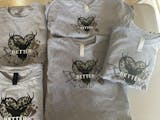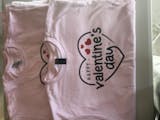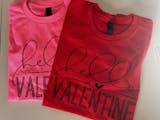Direct-to-Film (DTF) printing has become a popular method for garment decoration, offering versatility and high-quality results. A key component of efficient DTF printing is the use of gang sheets. A gang sheet is simply a single sheet of printing material that contains multiple copies of the same or different designs. These designs are arranged closely together to maximize the use of the printing material and minimize waste. This article will guide you through understanding and creating DTF gang sheets, covering everything from the basics to advanced techniques.
What is Gang Sheet Printing?
Gang printing involves placing multiple designs (designs can vary in size and/or color) on a single sheet of material. This method is commonly used in various printing processes, including offset and digital printing. The goal is to optimize the use of printing materials such as paper, film, or other substrates. Here are the main benefits of using gang sheets:
- Cost Savings: By combining multiple print jobs onto a single sheet, the cost of setup, materials, and labor is shared across all designs, making it a cost-effective solution for small-batch or custom orders.
- Reduced Setup Time: Printing multiple designs in one run reduces the need for frequent setup changes between different jobs. This saves time and increases overall production efficiency.
- Optimized Material Usage: Gang sheet printing allows for the efficient use of printing materials, minimizing waste and maximizing the value of each sheet.
- Consistent Print Quality: Printing multiple garments with the same design in a single run can contribute to consistent print quality across the entire batch, ensuring uniformity and customer satisfaction.
- Enhanced Flexibility: Printers can adapt to varying customer demands and market trends more easily with gang sheet printing. The flexibility to accommodate different designs and orders makes it easier to respond to changing preferences.
Why DTF is the Best Choice for Gang Sheets
While various methods exist for garment decoration using gang sheet printing, DTF printing stands out as the superior choice for custom DTF transfers. DTF, or Direct-to-Film printing, utilizes a PET film to transfer designs onto garments.
DTF excels in several areas:
- Fabric Compatibility: DTF works on all types of fabrics, unlike sublimation which is limited to synthetic materials.
- Detail: DTF printing produces photo-realistic details, ensuring intricate designs are accurately transferred.
- Color: DTF allows for full-color printing, enabling vibrant and complex designs.
- Texture: DTF prints are soft, and while large solid designs may have a hand feel, it is generally less noticeable compared to other methods.
- Durability: DTF prints are durable, flexible, and long-lasting, ensuring your designs withstand multiple washes.
Designing a DTF Gang Sheet
Before you start designing, it’s essential to grasp the ideal design size for various placements on a garment. While you have the freedom to choose personalized images, certain placements can enhance the overall fashion appeal.
Gang Sheet Size Guide
The following chart provides guidelines for design sizes and positions for different areas on a garment. This chart serves as a guide for both design creation and placement instructions for heat pressing.
| Print Location | Width | Height | Average Adult Size | Average Youth Size | Placement |
|---|---|---|---|---|---|
| Left Chest | 2.5″-5″ | 2.5″-5″ | 4″ width, 2″ height | 3″ width, 1.5″ height | 3″ – 4″ from collar, centered over far edge of collar |
| Center Chest | 6″-10″ | 6″-8″ | 8″ width, 4″ height | 6″ width, 3″ height | 4″ – 5″ from collar, centered – taller designs can start 3″ down |
| Full Front | 10″-12″ | 10″-14″ | 11″ width, 11″ height | 9″ width, 9″ height | 3″ from collar, centered – designs 6″ or shorter can go 4″ down |
| Oversize Front/Back | 12″-15″ | 14″-16″ | 13″ width, 15″ height | 10″ width, 12″ height | 2″ – 3″ down from collar, centered – oversize back placement 3.5″ down |
| Back Collar | 1″-3″ | 1″-3″ | 2″ width, 2″ height | 1.5″ width, 1.5″ height | 2″ down from collar, centered for large designs, 1″ down for smaller |
| Upper Back | 10″-14″ | 1″-6″ | 12″ width, 4″ height | 10″ width, 2.5″ height | 3″ – 4″ down from collar, centered, designs less than 2″ tall can go 5″ down |
| Full Back | 10″-14″ | 6″-15″ | 12″ width, 14″ height | 10″ width, 12″ height | 3″ – 4″ down from collar, centered |
| Sleeve | 1″-4″ | 1″-4″ | 2″ width, 2″ height | 1.5″ width, 1.5″ height | 1″ – 4″ from hem, centered on shoulder seam |
For example, when designing a left chest logo, a recommended size is about 4 inches in width and 2 inches in height for adult apparel. When transferring this design, it’s advisable to center the transfer over the far edge of the collar, positioned 3″ to 4″ away from the collar.
Software Options
To create your DTF gang sheets, you have several software options:
-
- Canva: Canva is a popular and user-friendly option for creating gang sheets for free.
- Photoshop: Photoshop is another widely used tool for creating gang sheets.
- Use our FREE We Print U Press Auto DTF Gang Sheet Builder
Step-by-Step Tutorial for Designing in Canva
Here’s how to design a gang sheet using Canva or watch this video on Canva Basics:
- Create a New Design: If you don't have a Canva account, sign up for free. Once logged in, click on "Custom Size" to start a new design.
- Create the Canvas: Set the canvas width to 22 inches wide. Set the length depending on the number of transfers needed.
- Upload Images: Use the “Upload” button to import your design images into the gang sheet file.
- Adjust & Design Your Layout: Drag the images onto the canvas and adjust their size and layout. Use the sizing guides to ensure optimal placement, such as aiming for 4 inches in width and 2 inches in height for a left chest logo.
- Save Your Design: Click the “Share” button, and then select “Download” to save your gang sheet design file as a PNG image.
Advanced Design Considerations
To ensure high-quality prints, keep these advanced design considerations in mind:
- Image Resolution: Ensure all images are at least 300dpi to avoid blurriness at your desired transfer size.
- Image Format: Use PNG format with a transparent background for individual design images or the entire gang sheet file. If you have access to vector files it is even better, as the design retains its quality when you adjust the size.
- Size: Ensure that the gang sheet file matches your DTF printer and film specifications and that each design image has the correct height and width for the intended transfer placement.
- Optimize Film Usage: Maximize film usage by arranging designs efficiently with minimal gaps. Rotate and flip designs as needed.
- Cutting Paths: Plan cutting paths to minimize the length of travel for the cutting tool or scissors when cutting out your transfers, reducing production time, and ensure that cutting paths avoid critical design elements.
How to Print a DTF Gang Sheet Transfer
The DTF printing process involves several steps: design creation, printing, powder application, curing, cutting, and heat transfer. Here's what you’ll need if you are printing or you can place your order for gang sheets directly on our website:
- DTF Printer: A high-quality, reliable printer is essential. Make sure to select a printer that fits your specific business needs. To help you, see our guide to choosing the ideal printer.
- Heat Press: A quality heat press is crucial for transferring designs onto garments. Our ultimate heat press setting guide will help you achieve the best results.
- Powder Shaker (Optional): A powder shaker provides a more efficient and even distribution of powder for optimized printing results. Some have integrated pre-heating and curing functions.
- Curing Oven (Optional): A curing oven activates the adhesive powder and enhances the quality and durability of the final print. It is preferred over a heat press for curing especially for businesses with bulk orders.
- Air Purifier (Optional): An air purifier is recommended for a clean and odor-free workspace, especially in enclosed spaces. Good ventilation is important for those who do not use an air purifier to avoid harmful fumes and particles.
- DTF Film: This film is the medium for transferring designs onto fabrics and is available in both roll and sheet format. It is an essential component in producing vibrant, durable, and high-quality prints.
- Adhesive Powder: This powder acts as a bonding agent between the printed ink and the fabric, ensuring optimal adhesion, durability, and color vibrancy.
- DTF Ink: Specially formulated for the DTF printing process, this ink is known for its vibrant color reproduction, flexibility, and durability.
Additional Information
DTF gang sheet transfers are versatile. You can store your popular designs for future orders.
Conclusion
Creating successful DTF gang sheets involves understanding optimal size, leveraging user-friendly tools, and incorporating design expertise. By following the fundamentals outlined in this article, you can ensure your prints are both efficient and visually compelling. We encourage you to share this post with fellow enthusiasts and leave us a comment to share your insights on DTF printing.








